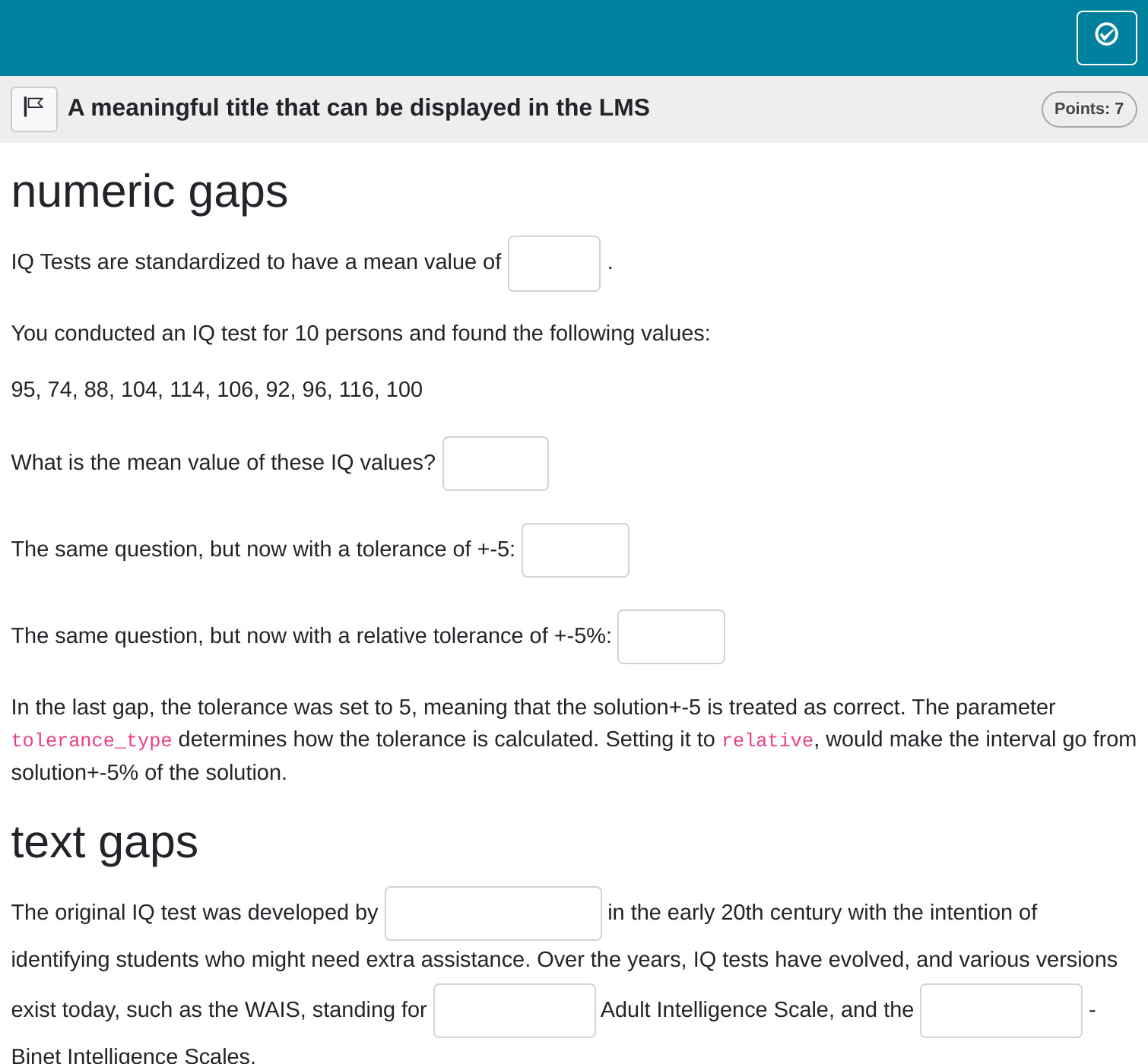In this task format, candidates are required to fill in one or more gaps. We believe this method is one of the most effective ways to assess students’ abilities, as it reduces the likelihood of guessing compared to multiple-choice questions. Emphasizing gap-fill tasks often leads to more reliable assessment outcomes.
Our package allows for the integration of both textual and numeric responses within a single task, offering instructors greater flexibility in designing assessments.
Minimum version
A minimum template is automatically created when you initiate an rqti
project through RStudio. Alternatively, it can be added by clicking on
New file -> R Markdown -> From Template. The
rqti templates end with rqti. Here we look
at the templates gap (simple) and
gap (complex).
The minimum you need to provide is the type: gap (or the
equivalent type: cloze) in the yaml-section and some text,
where at least one gap is used, in a section called
#question. Furthermore, when employing helper functions
from the rqti package, it is essential to ensure its prior loading.
---
type: gap
knit: rqti::render_qtijs
---
```{r, preparation}
library(rqti)
```
```{r, data}
iq <- round(rnorm(10, 100, 15))
mean_iq <- mean(iq)
```
# question
## numeric gaps
IQ Tests are standardized to have a mean value of <<100>>.
You conducted an IQ test for 10 persons and found the following values:
`r iq`
What is the mean value of these IQ values? `r gap_numeric(mean(iq))`
See `?gap_numeric` for more options (e.g. tolerance).
## text gaps
The original IQ test was developed by `r gap_text(c("Alfred Binet", "Binet", "A. Binet"))` in the early <<20th>> century with the intention of identifying students who might need extra assistance.
See `?gap_text` for more options (e.g. tolerance).
# feedback
1. IQ Tests are standardized to have a mean of 100.
1. The correct mean value for `r iq` is `r mean_iq`.
1. The original IQ test was developed by Alfred Binet.
1. It was in the 20th century.Clicking on the Knit-button will produce:

Alternatively, change the knit parameter to
knit: rqti::render_opal (see article Working with the OPAL API) to upload to OPAL
directly, producing:

As you can see, there are two ways to create a gap in an Rmd file:
- Put the correct answer between
<<…>>(or the equivalent<gap>…</gap>). Example:<<3.14>>or<<sometext>> - use the helper functions
?gap_numericand?gap_text(also see details below, section Helper function gap text, Helper function gap numeric)
By default, 1 point can be reached for each gap (specify
points in the helper function to your needs). The total
number of points for completing a task is defined as the sum of points
of all gaps.
Note that in this example, a feedback section was also provided. The
feedback is optional, but usually it is a good idea to give some
explanation for students. In gap tasks the feedback refers to the whole
task, not to a specific gap. Group your feedback into appropriate
sections, which can be opened/closed for better user experience (use
<details> and <summary> html
tags).
A great way to do this is to use <details> and
<summary> html tags:
<details><summary>Question1</summary>
Provide Feedback for Question 1
</details>
<details><summary>Question 2</summary>
Provide Feedback for Question 2
</details>will render as:
Question 1
Provide Feedback for Question 1Question 2
Provide Feedback for Question 2More control
If you want to have more fine-grained control, consider the RMD
template gap (complex), which uses more yaml attributes and
more complex calls of the helper functions.
---
type: gap # type of exercise
knit: rqti::render_qtijs # if you do not want our preview renderer, remove this
identifier: gap001 # think twice about this id for later data analysis!
title: A meaningful title that can be displayed in the LMS
---
```{r, preparation}
library(rqti)
```
```{r, data}
iq <- round(rnorm(10, 100, 15))
mean_iq <- mean(iq)
```
# question
## numeric gaps
IQ Tests are standardized to have a mean value of <<100>>.
You conducted an IQ test for 10 persons and found the following values:
`r iq`
What is the mean value of these IQ values? `r gap_numeric(mean(iq))`
The same question, but now with a tolerance of +-5: `r gap_numeric(mean(iq), tolerance = 5)`
The parameter `tolerance_type` determines how the tolerance is calculated.
The same question, but now with a relative tolerance of +-5%: `r gap_numeric(mean(iq), tolerance = 5, tolerance_type = "relative")`
## text gaps
The original IQ test was developed by `r gap_text(c("Alfred Binet", "Binet", "A. Binet"))` in the early 20th century with the intention of identifying students who might need extra assistance. Over the years, IQ tests have evolved, and various versions exist today, such as the WAIS, standing for `r gap_text("Wechsler", case_sensitive = F, tolerance = 2)` Adult Intelligence Scale, and the <<Stanford>>-Binet Intelligence Scales.
Please be advised that OPAL has introduced a new attribute for text gaps—`tolerance`—which now accommodates considerations for spelling errors. It is crucial to restrict the use of this attribute to the OPAL Learning Management System (LMS), as it may not be compatible with other Learning Management Systems. Furthermore, it is important to note that employing this attribute will result in the XML files being rendered invalid according to the QTI standard.
# feedback
1. IQ Tests are standardized to have a mean of 100.
1. The correct mean value for `r iq` is `r mean_iq`.
1. The original IQ test was developed by Alfred Binet.
1. WAIS: W stands for Wechsler
1. It is the Stanford-Binet Intelligence Scales.
<!-- If you prefer specific feedback for correct and incorrect solution, delete
the general feedback section and uncomment everything starting from the next
line:
# feedback+
Nice. (Only displayed when the solution is correct.)
# feedback-
Try again. (Only displayed if the solution is not correct.)
-->In OPAL this renders as :

yaml attributes
Feedback
Feedback can be provided with the section
- # feedback (general feedback, displayed every time, without conditions)
- # feedback+ (only provided if student reaches all points)
- # feedback- (only provided if student does not reach all points)
Helper function gap_numeric
This helper function is designed to generate a formatted string describing a gap in Rmd content, where the answer has a numeric type:
gap1 <- gap_numeric(solution = 1.4, tolerance = 10, tolerance_type = "relative",
points = 5, response_identifier = "mean_value",
include_lower_bound = TRUE, include_upper_bound = TRUE,
expected_length = 10, placeholder = "put mean value here")
cat(gap1)
<gap>{solution: [1.4], tolerance: 10.0, tolerance_type: relative, points: 5.0, response_identifier: mean_value, include_lower_bound: yes, include_upper_bound: yes, expected_length: 10.0, placeholder: put mean value here, type: numeric}</gap>As you can see, YAML is ultimately used, but for most users, it is
more convenient to have a dedicated R function instead. Let us now look
at the argument list of gap_numeric:
tolerance_type
Defines how the tolerance is calculated. For instance, if the solution is 50 and the tolerance is 10:
- Setting
tolerance_typetorelativeresults in a correct answer range from 45 to 55 (50 ± 10%). - Setting it to
absolutecreates a range from 40 to 60 (50 ± 10).
response_identifier
This is the ID of the gap, useful for later data analysis. The default has the format “response_1”, “response_2”. If you are doing extensive data analysis later on, it makes sense to specify a meaningful identifier.
expected_length
Specifies the size of the text input field in the content delivery engine. This value is not directly assigned, it is calculated based on the number of symbols in the solution value. Browsers display the input field length inconsistently, but we have endeavored to establish sensible defaults.
Helper function gap_text
This helper function is designed to generate a formatted string describing a gap in Rmd content, where the answer is a string:
gap2 <- gap_text(gap_text(c("Bildungsportal Sachsen", "Bildungs Portal Sachsen"),
tolerance = 4, case_sensitive = FALSE,
placeholder = "text without special characters",
expected_length = 25))
cat(gap2)
<gap>{solution: [<gap>{solution: [Bildungsportal Sachsen,Bildungs Portal Sachsen], tolerance:, 4.0, case_sensitive: no, points: 1.0, expected_length: 25.0, placeholder: text without, special characters, type: text_opal}</gap>], case_sensitive: no, points: 1.0, expected_length: 205.0, type: text}</gap>Argument list of gap_text:
tolerance (works only in LMS OPAL)
Defines how many characters will be taken into account to tolerate spelling mistakes. The exact algorithm of OPAL is unclear.
case_sensitive (works only in LMS OPAL)
Determines whether the evaluation of the correct answer is case
sensitive. Default is FALSE.
response_identifier
This is the ID of the gap, useful for later data analysis. The default has the format “response_1”, “response_2”. If you are doing extensive data analysis later on, it makes sense to specify a meaningful identifier.
expected_length
Specifies the size of the text input field in the content delivery engine. The default value is calculated based on the number of symbols in the solution value. Browsers display the input field length inconsistently, but we have endeavored to establish sensible defaults. Please adjust to your needs.
Some advice on gap tasks
Gap tasks are generally foolproof, offering an ideal format by minimizing guessing and often presenting a reasonably high level of difficulty. Numeric tasks, involving calculations that are typically not guessable, are especially effective. While crafting text gaps may be more intricate, the option to offer multiple alternative solutions and leverage OPAL to accommodate spelling errors enhances their versatility. Nevertheless, it is important to note that, like any task, gap tasks can be poorly designed, so be mindful in their creation.
As mentioned earlier, numeric and text gaps can be combined in a single task, making them quite versatile. In fact, the flexibility of gaps allows for the integration of various task types within a single task. For instance, to incorporate single-choice questions alongside gaps, you can use a numeric gap for the single-choice question and include the answer options directly in the question. For example, “Fill in the blank: ____ (0 = not significant, 1 = significant)”. This approach enables you to use gaps for many types of questions, highlighting their exceptional adaptability.